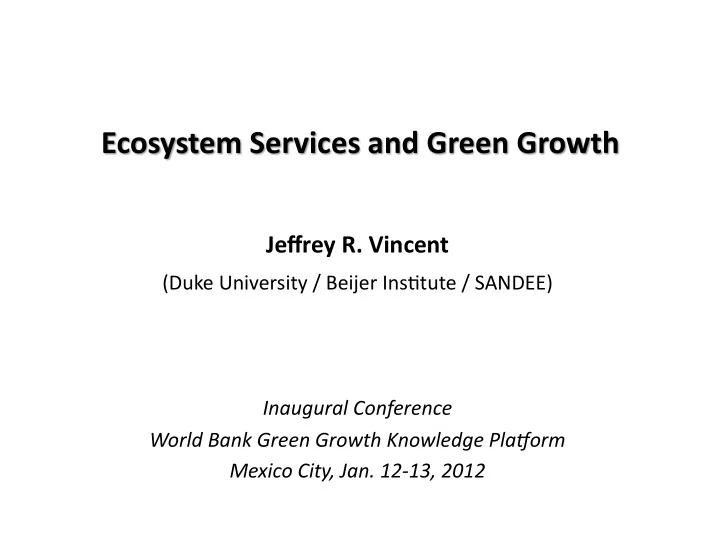

Ecosystem ¡Services ¡and ¡Green ¡Growth ¡ Jeffrey ¡R. ¡Vincent ¡ (Duke ¡University ¡/ ¡Beijer ¡Ins3tute ¡/ ¡SANDEE) ¡ ¡ ¡ ¡ Inaugural ¡Conference ¡ World ¡Bank ¡Green ¡Growth ¡Knowledge ¡Pla8orm ¡ Mexico ¡City, ¡Jan. ¡12-‑13, ¡2012 ¡
Objec3ve ¡ • To ¡review ¡evidence ¡on ¡the ¡effect ¡of ¡changes ¡in ¡the ¡supply ¡of ¡ ecosystem ¡services, ¡and ¡programs ¡to ¡increase ¡their ¡supply, ¡on ¡ near-‑term ¡economic ¡growth ¡ – Near-‑term : ¡few ¡years ¡to ¡a ¡decade ¡or ¡so ¡ – Economic ¡growth : ¡conven3onal ¡monetary ¡measure ¡of ¡change ¡in ¡ economic ¡output ¡(e.g., ¡GDP) ¡
Regula>ng ¡services ¡ Already ¡reflected ¡in ¡overall ¡GDP, ¡ • but ¡misallocated ¡between ¡sectors ¡ Paper ¡focuses ¡on ¡domes>c ¡services ¡ •
Key ¡condi3ons ¡for ¡near-‑term ¡growth ¡s3mulus ¡ 1. A ¡conserva3on ¡program ¡must ¡either ¡restore ¡a ¡degraded ¡ ecosystem ¡or ¡reduce ¡the ¡loss ¡of ¡an ¡intact ¡one ¡ 2. This ¡posi3ve ¡ecosystem ¡change ¡must ¡increase ¡the ¡supply ¡of ¡ an ¡ecosystem ¡service ¡ 3. The ¡increased ¡supply ¡must ¡occur ¡within ¡a ¡short ¡period ¡of ¡ 3me ¡ 4. The ¡service ¡must ¡be ¡economically ¡valuable ¡ ¡
4. ¡The ¡service ¡must ¡be ¡economically ¡valuable ¡ • Valua3on ¡literature: ¡emphasis ¡on ¡forest ¡ecosystem ¡services ¡ • General ¡finding ¡of ¡studies ¡by ¡economists: ¡small, ¡with ¡great ¡ spa3al ¡varia3on ¡ – LampieV ¡& ¡Dixon ¡(1995), ¡Pearce ¡(2001), ¡Croitoru ¡(2007): ¡on ¡average, ¡ regula3ng ¡services ¡= ¡5-‑15% ¡of ¡total ¡value ¡of ¡forest ¡goods ¡and ¡services ¡ • Timber ¡≈ ¡⅓-‑ ¡½ ¡ – Timber ¡harvest ¡≈ ¡0.2% ¡of ¡global ¡GDP ¡ – All ¡services ¡of ¡forests—not ¡just ¡regula3ng—probably ¡< ¡1% ¡of ¡global ¡GDP ¡ • Caveats: ¡incomplete ¡es3mates, ¡subop3mal ¡management ¡ • Costanza ¡et ¡al. ¡(1997): ¡forest ¡ecosystem ¡services ¡= ¡25% ¡of ¡global ¡GDP; ¡ ¡ ¡ ¡ ¡ ¡ ¡ ¡ ¡all ¡ ecosystem ¡services ¡≈ ¡2 ¡× ¡global ¡GDP ¡
Inadequate ¡control ¡for ¡confounding ¡factors ¡ ¡ exaggerated ¡es3mates ¡of ¡service ¡values ¡ • Flood ¡mi3ga3on ¡by ¡forests ¡ – Bradshaw ¡et ¡al. ¡(2007): ¡natural ¡forest ¡area ¡has ¡significant, ¡nega3ve ¡ effect ¡on ¡flood ¡frequency ¡in ¡56 ¡developing ¡countries ¡during ¡1990-‑2000 ¡ – van ¡Dijk ¡et ¡al. ¡(2009): ¡popula3on ¡density ¡explained ¡83% ¡of ¡the ¡ varia3on ¡in ¡reported ¡flood ¡frequency, ¡with ¡forest ¡cover ¡explaining ¡less ¡ than ¡1% ¡of ¡the ¡remaining ¡17% ¡
• Pollina3on ¡services ¡by ¡natural ¡habitat ¡ – Observed ¡nega3ve ¡rela3onship ¡between ¡crop ¡yield ¡and ¡distance ¡to ¡ natural ¡habitat ¡typically ¡assumed ¡to ¡be ¡due ¡to ¡reduced ¡pollina3on ¡ (Rickens ¡et ¡al. ¡2008) ¡ • But: ¡produc3vity ¡can ¡decline ¡for ¡other ¡reasons ¡(e.g., ¡soil ¡fer3lity) ¡ – Meta-‑analysis ¡(Rickens ¡et ¡al. ¡2008): ¡number ¡and ¡diversity ¡of ¡ pollinators ¡declines ¡significantly ¡with ¡distance, ¡but ¡fruit ¡set ¡does ¡not ¡ • ¡pollinators ¡not ¡scarce ¡ – Damage ¡costs ¡(e.g., ¡reduc3on ¡in ¡gross ¡revenue) ¡and ¡replacement ¡costs ¡ (e.g., ¡ren3ng ¡bee ¡hives) ¡can ¡exaggerate ¡economic ¡losses: ¡inadequately ¡ account ¡for ¡farmer ¡responses ¡(McConnell ¡and ¡Bockstael ¡2005) ¡ • Winfree ¡et ¡al. ¡(2011): ¡> ¡2× ¡for ¡watermelons ¡in ¡NJ ¡and ¡PA ¡
Spa3al ¡varia3on ¡in ¡values: ¡ Pananayak ¡& ¡Kramer ¡(2001) ¡
2. ¡Posi3ve ¡ecosystem ¡change ¡must ¡ ¡ increase ¡the ¡supply ¡of ¡an ¡ecosystem ¡service ¡ • Need ¡bener ¡evidence ¡that ¡this ¡happens ¡ – Forests ¡and ¡floods, ¡droughts ¡ – Natural ¡habitat ¡and ¡pollina3on ¡ • Services ¡are ¡not ¡necessarily ¡spa3ally ¡compa3ble ¡ – E.g., ¡3mber ¡and ¡water ¡quality ¡ – Diseconomies ¡of ¡scope: ¡op3mal ¡ecosystem ¡management ¡may ¡require ¡ spa3al ¡specializa3on, ¡instead ¡of ¡managing ¡for ¡all ¡services ¡in ¡all ¡areas ¡
3. ¡Increased ¡supply ¡of ¡a ¡service ¡ ¡ must ¡occur ¡within ¡a ¡short ¡period ¡of ¡3me ¡ • Restore ¡degraded ¡ecosystems ¡ – Review ¡of ¡240 ¡studies ¡(Jones ¡and ¡Schmitz ¡2009): ¡“startling ¡evidence ¡ that ¡most ¡ecosystems ¡globally ¡can, ¡given ¡human ¡will, ¡recover ¡from ¡ very ¡major ¡perturba3ons ¡on ¡3mescales ¡of ¡ decades ¡to ¡half-‑centuries ” ¡ Focused ¡on ¡suppor3ng ¡services ¡ “many ¡of ¡the ¡ecosystems ¡considered ¡were ¡rela3vely ¡undegraded ¡at ¡the ¡ outset” ¡(Bullock ¡et ¡al. ¡2011, ¡p. ¡544) ¡
• Prevent ¡loss ¡of ¡intact ¡ecosystems ¡ – Local ¡effects, ¡where ¡ecosystems ¡being ¡lost ¡rapidly ¡and ¡provide ¡ important ¡services ¡ – Greatest ¡poten3al ¡for ¡large ¡impact: ¡REDD ¡(transboundary) ¡
1. ¡Conserva3on ¡program ¡must ¡either ¡restore ¡a ¡degraded ¡ ecosystem ¡or ¡reduce ¡the ¡loss ¡of ¡an ¡intact ¡one ¡ • Programs ¡to ¡reduce ¡ecosystem ¡loss ¡ – Protected ¡areas ¡(PAs) ¡ – Payments ¡for ¡ecosystem ¡services ¡(PES) ¡ – Integrated ¡conserva3on-‑development ¡projects ¡(ICDPs) ¡ • Impact ¡evalua3ons ¡of ¡conserva3on ¡programs ¡ – Ecosystem ¡loss ¡with ¡program ¡vs. ¡without ¡program ¡ – S3ll ¡rare: ¡6-‑12 ¡studies ¡for ¡each ¡type, ¡limited ¡geographical ¡coverage ¡ • Focus ¡on ¡reduced ¡deforesta3on ¡ – Es3mated ¡impact: ¡very ¡small ¡
Are ¡impact ¡evalua3ons ¡too ¡pessimis3c? ¡ • Reduced ¡deforesta3on ¡not ¡only ¡or ¡primary ¡objec3ve ¡of ¡forest ¡ protec3on: ¡ ¡reduced ¡logging, ¡reduced ¡poaching ¡ • Protec3ng ¡less ¡threatened ¡ecosystems ¡might ¡be ¡economically ¡ efficient ¡ – Site ¡1: ¡deforested ¡in ¡ n ¡years ¡ ¡Site ¡2: ¡deforested ¡now ¡ V V 1 2 – Site ¡1 ¡should ¡be ¡protected ¡if: ¡ n > ( ) P P 1 r + 2 1 V i ¡= ¡conserva3on ¡value ¡ ¡ P i ¡= ¡acquisi3on ¡price ¡ ¡ r ¡= ¡discount ¡rate ¡ – Results ¡of ¡impact ¡evalua3ons ¡need ¡to ¡be ¡bener ¡integrated ¡with ¡ informa3on ¡on ¡conserva3on ¡benefits ¡and ¡costs ¡
Poverty ¡allevia3on ¡ • Major ¡reason ¡for ¡development ¡organiza3ons’ ¡emphasis ¡on ¡ economic ¡growth ¡ • Conserva3on ¡programs ¡and ¡poverty ¡allevia3on ¡ – Theory ¡ • PAs: ¡nega3ve ¡effect ¡ • PES: ¡mixed ¡effects ¡ – Prac3ce ¡ • PAs ¡(impact ¡evalua3ons): ¡surprisingly ¡large, ¡posi3ve ¡local ¡effects ¡ – Seemingly ¡due ¡to ¡tourism ¡ – Conserva3on ¡vs. ¡poverty: ¡win-‑win ¡or ¡win-‑draw, ¡but ¡“wins” ¡in ¡different ¡places ¡ • PES ¡(case ¡studies): ¡small ¡gains ¡for ¡rural ¡landowners, ¡linle ¡for ¡rural ¡landless ¡ – If ¡like ¡condi3onal ¡cash ¡transfer ¡programs, ¡then ¡MPC ¡payments ¡is ¡high; ¡ ¡ ¡ ¡ ¡ ¡ ¡ ¡ ¡ ¡ ¡ ¡ ¡s3mulus ¡is ¡near-‑term, ¡not ¡long-‑term ¡
Recommend
More recommend